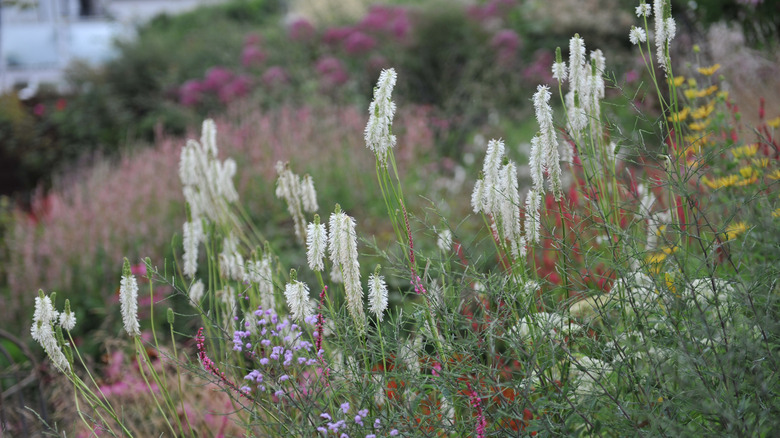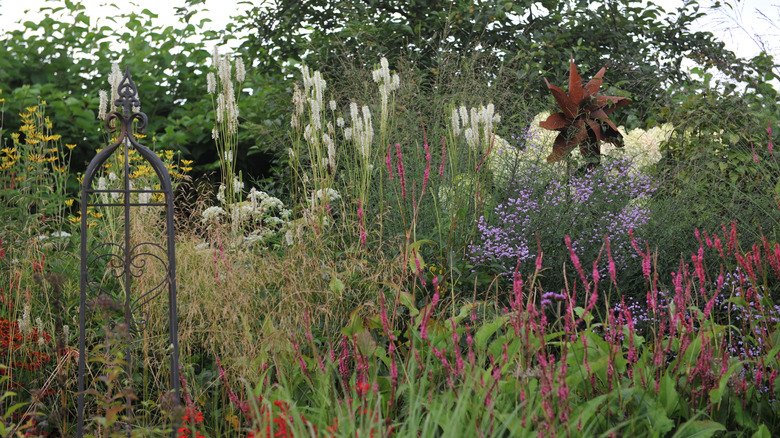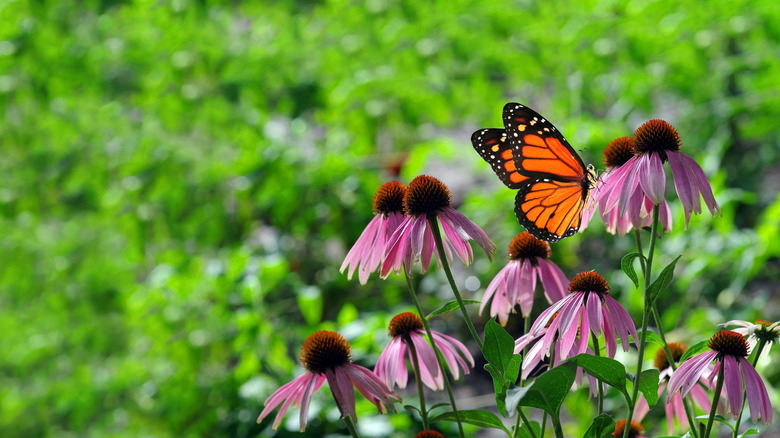The Low-Maintenance Herb That Can Attract Wildlife To Your Backyard With Ease
Whether you're looking to grow a garden with practical yields of fruit and veggies, or you just want a beautiful backyard to sit in and read amid some flowers, attracting wildlife and pollinators is essential for a healthy ecosystem. Pollinators carry pollen between flowers to fertilize fruits and seeds, and pollination can take place throughout the year — plants have evolved to bloom in different seasons to decrease competition at peak flowering times. However, birds are also important for your garden, as they both eat insects that might otherwise cause trouble and help disperse seeds they ingest in new areas when they travel. If you're looking to grow a unique flower that brings all the birds to your yard, alongside various bees, consider investing in some American burnet (Sanguisorba canadensis).
American burnet is a herbaceous perennial wildflower that's native to the United States and Canada; it's especially known for growing in wet, marshy areas and bogs between USDA hardiness zones 4 and 6. Most native blooms are going to be found along the West Coast, from the Pacific Northwest through Alaska, as well as on the majority of the eastern seaboard. However, American burnet is considered threatened or endangered in multiple states. Luckily, this is one endangered U.S. plant that you can grow in your garden as a boon both for its native population and other plants it thrives alongside.
Growing American burnet in your backyard
This member of the Rosaceae family does require quite specific environmental conditions to grow, owing to its origins in swampy environments. American burnet thrives in very moist soil with high concentrations of organic matter, ideally with full sun exposure. In fact, it's a plant that enjoys flooded environments and frequent puddles of standing water. Depending on where you live, this means you'll have to be careful about seeing your plants become a mosquito nightmare, especially as global climate change increases the range within which mosquitoes can spread. Luckily, mosquitoes are among the pests that birds are known to eat, so if your garden is set to attract feathery friends with plants like American burnet, these woes may balance out over time.
American burnet can be propagated via division, root cuttings, or stem cuttings, but it's worth noting that its fuzzy-looking white flowers bloom incredibly late in the season, sometimes as late as October. If you aren't seeing flowers coming out when you expect, it might just be worth waiting patiently. Waiting through the fall also presents the unique experience of seeing American burnet leaves turn reddish-yellow alongside the white flowers. The low-maintenance nature of this flora means it's great to set and forget and enjoy its blooming season when that comes around.
Consider building an entire pollinator garden around American burnet
While American burnet is a perfect herb to attract pollinators like birds to your backyard, you can bolster conservation efforts even more by building an entire pollinator garden around this swampy wildflower. Native plants in general will be heartier and less maintenance to grow, with one easy choice being a local strain of milkweed. This flower is a well-known butterfly attractor, therefore helping to bring in another pollinator species and providing more food for birds that get drawn in by your American burnet. Other options for the best plants to grow in a pollinator garden include marigolds, lavender, and dahlias.
Pollinator populations are at risk due to a loss of habitats and the widespread use of pesticides, so it's important to develop thriving local ecosystems that can help the planet continue its natural cycles. Growing some American burnet is a great place to start. Just be sure to weed and water your garden to keep it happy and healthy, as this kind of ecosystem built around perennial flowers will pay dividends for a great many growing seasons.


